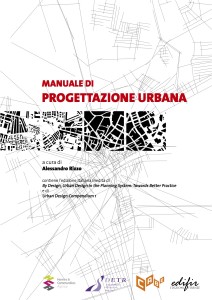URBAN DESIGN HANDBOOK
Edited by Alessandro Rizzo, Edifir Edizioni, Firenze, 2016

Since the end of the 90’s, the british government has started a deep and accurate review of its planning tools and urban design procedures based on a renovated awareness of the positive potential that any urban environment is capable to convey in social, cultural and economic terms. As a first step along that path, the multi-disciplinary team led by Lord Richard Rogers and known as the “Urban Task Force” took on the essential task to outline what the future of british cities could and should be, stating the basic principles and the strategies through which the enourmous potential that lies within the very idea of urban agglomeration could be developed, minimizing at the same time all unavoidable side effects on citizens as much as on the natural environment. Within the 2004 London Plan, which owes a lot to the work of the Urban Task Force, once abstract concepts such as environmental, social and economic sustainability within the process of production of the urban fabric are actualized through clearly defined strategies and methodologies, aiming to reach higher quality standards in the physical and social realms. Among these strategies, the one which mostly affects the planning system transfers much of the tasks ad targets once inherent ot the modernist concept of urban planning towards a new and much more comprehensive definition of urban design. A new idea is introduced, by which planning is implemented through design, rather than strict ties, restrictions and functional zoning within a single and omniscient (in time and space) masterplan. To reach such a challenging target, the british planning agencies started since the year 2000 to develop a series of guidelines and handbooks to guide local authorities and private investors and designers towards the creation of urban spaces of increased quality, on which to base a fair, pleasing and stimulating cohexistence within high density built environments. The texts “By Design – Urban Design in the Planning System” issued by the Commission for Architecture and the Built Environment, and the “Urban Design Compendium”, issued by the Homes and Communities Agency, stand among the most helpful and comprehensive means by which to understand basic principles and final aims of a new approach to planning, and appropriately set the design process at the urban scale from the initial phases. The book, which includes the previously unreleased italian edition of both the above texts, is intended to address officers and councillors in local authorities in addition to managers, designers, investors and builders in the private sector, and ultimately anyone who cares about the space in which we all live and work.

